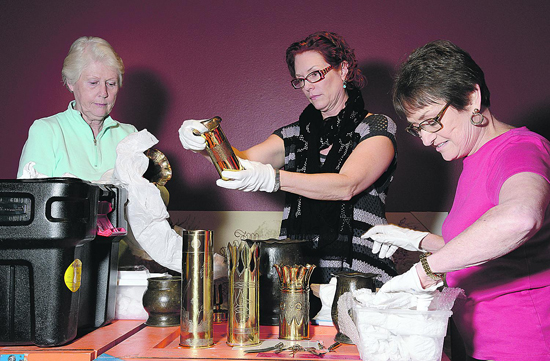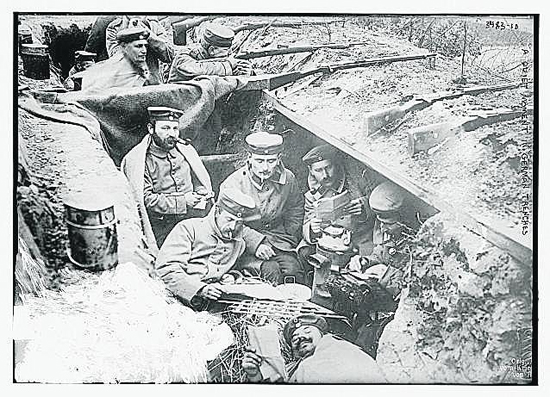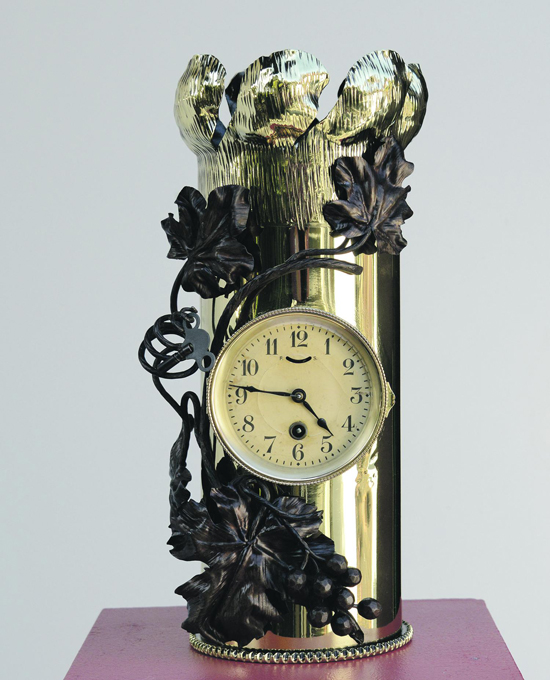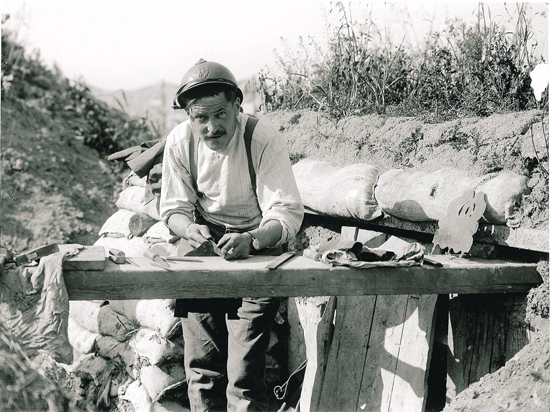| | Published January 15th, 2014
| Artistry from Agony
Saint Mary's Museum of Art commemorates the 100th anniversary of
World War I
| | By Laurie Snyder |  | | From left, specially trained volunteer Julie Kline, Museum Registrar Julie Armistead and Museum Director Carrie Brewster at Saint Mary's College Museum of Art carefully begin uncrating and inspecting works of World War I trench art Jan. 10 in preparation for display as part of the acclaimed exhibition, "From Swords to Plowshares." Photo Ohlen Alexander
|
"Bombardment, barrage, curtain-fire, mines, gas, tanks, machine-guns, hand-grenades - words, words, but they hold the horror of the world." - Erich Maria Remarque, "All Quiet on the Western Front"
 Europe's flowering youth scythed senselessly from Flanders Fields, gassed and left gasping final breaths at Ypres Salient. Callow aristocrats cut down by crusty coal miners. Ploughmen purged not by the pens of poets - but by their flame throwers. It was the time of "The Great War" - World War I - the first in which chemical warfare was used, the first in which civilians dodged man-made death raining from the skies, and the first of the 20th century in which survivors witnessed the depravity of genocide.
Europe's flowering youth scythed senselessly from Flanders Fields, gassed and left gasping final breaths at Ypres Salient. Callow aristocrats cut down by crusty coal miners. Ploughmen purged not by the pens of poets - but by their flame throwers. It was the time of "The Great War" - World War I - the first in which chemical warfare was used, the first in which civilians dodged man-made death raining from the skies, and the first of the 20th century in which survivors witnessed the depravity of genocide.
 Although the world would be brought to its knees by the time guns fell silent at the 11th hour on the 11th day of the 11th month in 1918, humanity did not realize, as 1914 dawned, that it was heading into the seventh circle of hell. Sixteen million combatants and civilians were killed by the war and its fallout of famine and disease. Rudyard Kipling went to his grave in 1936 without ever finding his only son's body. J.R.R. Tolkien, future author of "The Lord of the Rings," contracted trench fever during front-line duty on the Somme - one of the more than 21 million eventually counted among the wounded. Many suffered from shell shock - what we now call Post-Traumatic Stress Disorder (PTSD).
Although the world would be brought to its knees by the time guns fell silent at the 11th hour on the 11th day of the 11th month in 1918, humanity did not realize, as 1914 dawned, that it was heading into the seventh circle of hell. Sixteen million combatants and civilians were killed by the war and its fallout of famine and disease. Rudyard Kipling went to his grave in 1936 without ever finding his only son's body. J.R.R. Tolkien, future author of "The Lord of the Rings," contracted trench fever during front-line duty on the Somme - one of the more than 21 million eventually counted among the wounded. Many suffered from shell shock - what we now call Post-Traumatic Stress Disorder (PTSD).
 Now, thanks to Saint Mary's College Museum of Art, additional light is being shed on this seminal period in world history. Beginning Feb. 2, "From Swords to Plowshares: Metal Trench Art from World War I" will feature more than 150 metal objects created by artists from virtually all of the countries that were involved in the conflict, says Heidi Donner, manager of education and public information for the museum. She describes the exhibition as "a powerful mix of art and history."
Now, thanks to Saint Mary's College Museum of Art, additional light is being shed on this seminal period in world history. Beginning Feb. 2, "From Swords to Plowshares: Metal Trench Art from World War I" will feature more than 150 metal objects created by artists from virtually all of the countries that were involved in the conflict, says Heidi Donner, manager of education and public information for the museum. She describes the exhibition as "a powerful mix of art and history."
 Visitors will experience the war in profoundly personal ways via veterans' interviews, film footage and period music while viewing remarkable works of art.
Visitors will experience the war in profoundly personal ways via veterans' interviews, film footage and period music while viewing remarkable works of art.
 "The ingenuity and skill range from primitive decorated artillery shell cases executed in trenches to elaborately embellished artillery shell lamps, vases, cigarette lighters, and ashtrays exhibiting extraordinary craftsmanship. The pieces are as varied and unique as the military and civilian artists who created them," says Donner.
"The ingenuity and skill range from primitive decorated artillery shell cases executed in trenches to elaborately embellished artillery shell lamps, vases, cigarette lighters, and ashtrays exhibiting extraordinary craftsmanship. The pieces are as varied and unique as the military and civilian artists who created them," says Donner.
 "Unlike commissioned paintings and war memorials, which represented war from a distance, trench art was made from the waste of war itself and utilized the vehicles of death and mutilation directly," writes British archaeologist Nicholas Saunders, Ph.D., author of "Trench Art: Lost Worlds of the Great War."
"Unlike commissioned paintings and war memorials, which represented war from a distance, trench art was made from the waste of war itself and utilized the vehicles of death and mutilation directly," writes British archaeologist Nicholas Saunders, Ph.D., author of "Trench Art: Lost Worlds of the Great War."
 "Trench art was made for a variety of practical reasons - for sale, barter and personal use - but could also possess deeper spiritual meanings associated with religious belief, grief and mourning, and relief or guilt at surviving war when so many did not."
"Trench art was made for a variety of practical reasons - for sale, barter and personal use - but could also possess deeper spiritual meanings associated with religious belief, grief and mourning, and relief or guilt at surviving war when so many did not."
 Kicking off the exhibition will be award-winning author, Adam Hochschild. A former editor of Mother Jones and current journalism teacher at the University of California, Berkeley, Hochschild also wrote "King Leopold's Ghost: A Story of Greed, Terror and Heroism in Colonial Africa." His most recent book, "To End All Wars: A Story of Loyalty and Rebellion, 1914-1918," explores the interplay between generals, cabinet ministers, ordinary trench soldiers, and pacifists. His free lecture, "The War Within the War: 1914-1918," begins at 2 p.m. Feb. 2 at SMC's LeFevre Theatre. A parallel exhibition, "Songs of the Patriot," explores how Irving Berlin and other noted composers of the era addressed the feelings of Americans through music as the war raged.
Kicking off the exhibition will be award-winning author, Adam Hochschild. A former editor of Mother Jones and current journalism teacher at the University of California, Berkeley, Hochschild also wrote "King Leopold's Ghost: A Story of Greed, Terror and Heroism in Colonial Africa." His most recent book, "To End All Wars: A Story of Loyalty and Rebellion, 1914-1918," explores the interplay between generals, cabinet ministers, ordinary trench soldiers, and pacifists. His free lecture, "The War Within the War: 1914-1918," begins at 2 p.m. Feb. 2 at SMC's LeFevre Theatre. A parallel exhibition, "Songs of the Patriot," explores how Irving Berlin and other noted composers of the era addressed the feelings of Americans through music as the war raged.
 "It wasn't inevitable. ... There was a lot of tension in Europe but, in early June 1914, everyone was getting along with each other quite well. There was a huge amount of trade across borders ... people were focused on other things. ... Then this chain of events begins with the assassination of the Archduke. If that hadn't happened, there might well have been a war or wars in Europe, but not necessarily drawing in everybody in the way it happened," said Hochschild in a 2011 History News Network interview. "The First World War had enormous unintended consequences.... And it permanently darkened everybody's point of view about humanity and what was possible in the world."
"It wasn't inevitable. ... There was a lot of tension in Europe but, in early June 1914, everyone was getting along with each other quite well. There was a huge amount of trade across borders ... people were focused on other things. ... Then this chain of events begins with the assassination of the Archduke. If that hadn't happened, there might well have been a war or wars in Europe, but not necessarily drawing in everybody in the way it happened," said Hochschild in a 2011 History News Network interview. "The First World War had enormous unintended consequences.... And it permanently darkened everybody's point of view about humanity and what was possible in the world."
 Conversely, says Donner, there is something noble about human beings wanting to beautify their environment - especially after the harshest, most heartrending of experiences.
Conversely, says Donner, there is something noble about human beings wanting to beautify their environment - especially after the harshest, most heartrending of experiences.
 

|
 In Flanders Fields In Flanders Fields
 By John McCrae, May 1915 By John McCrae, May 1915

 In Flanders fields the poppies grow
In Flanders fields the poppies grow
 Between the crosses, row on row,
Between the crosses, row on row,
 That mark our place; and in the sky
That mark our place; and in the sky
 The larks, still bravely singing, fly
The larks, still bravely singing, fly
 Scarce heard amid the guns below.
Scarce heard amid the guns below.

 We are the Dead. Short days ago
We are the Dead. Short days ago
 We lived, felt dawn, saw sunset glow,
We lived, felt dawn, saw sunset glow,
 Loved and were loved, and now we lie
Loved and were loved, and now we lie
 In Flanders fields.
In Flanders fields.

 Take up our quarrel with the foe:
Take up our quarrel with the foe:
 To you from failing hands we throw
To you from failing hands we throw
 The torch; be yours to hold it high.
The torch; be yours to hold it high.
 If ye break faith with us who die
If ye break faith with us who die
 We shall not sleep, though poppies grow
We shall not sleep, though poppies grow
 In Flanders fields.
In Flanders fields.
|
 World War I Resources
World War I Resources

 Books:
Books:
 "All Quiet on the Western Front," Erich Maria Remarque (1929)
"All Quiet on the Western Front," Erich Maria Remarque (1929)
 "August 1914," Alexander Solzhenitsyn (reissued with new content, 1984)
"August 1914," Alexander Solzhenitsyn (reissued with new content, 1984)
 "Counter-Attack and Other Poems," Siegfried Sassoon (1918)
"Counter-Attack and Other Poems," Siegfried Sassoon (1918)
 "Memoirs of an Infantry Officer," Siegfried Sassoon (1930)
"Memoirs of an Infantry Officer," Siegfried Sassoon (1930)
 "Poems/ with an introduction by Siegfried Sassoon," Wilfred Owen (1920)
"Poems/ with an introduction by Siegfried Sassoon," Wilfred Owen (1920)
 "Regeneration," Pat Barker (1991)
"Regeneration," Pat Barker (1991)

 Films:
Films:
 "Behind the Lines" (R; Gillies Mackinnon with Jonathan Pryce, 1997)
"Behind the Lines" (R; Gillies Mackinnon with Jonathan Pryce, 1997)
 "Beneath Hill 60" (R; Jeremy Sims with Brendan Cowell, 2010)
"Beneath Hill 60" (R; Jeremy Sims with Brendan Cowell, 2010)
 "Lawrence of Arabia" (PG; David Lean with Peter O'Toole, 1962)
"Lawrence of Arabia" (PG; David Lean with Peter O'Toole, 1962)
 "Paths of Glory" (Approved; Stanley Kubrick with Kirk Douglas, 1957)
"Paths of Glory" (Approved; Stanley Kubrick with Kirk Douglas, 1957)
 "The Great War and the Shaping of the 20th Century" (award-winning PBS documentary series, 1996)
"The Great War and the Shaping of the 20th Century" (award-winning PBS documentary series, 1996)
|
 | | A quiet moment in German trenches
Library of Congress Prints and Photographs Division Washington, D.C. 20540 USA
|  | | The shell and clock in this piece are of German origin. Nothing besides the name "Kurth" is known of the maker, who may have been French, Belgian or German. The maker delicately applied the bronze cast, wine grape vines, and clock as a utilitarian decoration to the large center artillery shell. Part of a set of three, this piece is unusual in size and technique highlighting the unique craftsmanship of trench artistry. Hollingsworth Fine Art Collection, Florida. Photo Ohlen Alexander
|  | | Belgian Soldier with tools. Photo provided
| | | | | | | | | |
| | | print story
Before you print this article, please remember that it will remain in our archive for you to visit anytime.
download pdf
(use the pdf document for best printing results!) | | | Comments | | |
| | | | | | | | | | | | | | | | |





